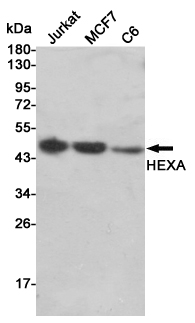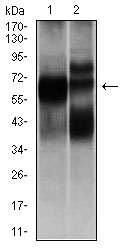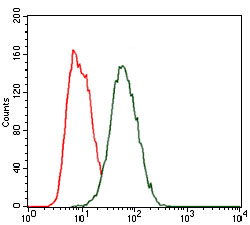-
Product Name
Anti-HEXA (1G3) Mouse antibody
- Documents
-
Description
HEXA (1G3) Mouse monoclonal antibody
-
Tested applications
WB, FC
-
Species reactivity
Human
-
Isotype
Mouse IgG2b
-
Preparation
Antigen: Purified recombinant fragment of human HEXA expressed in E. Coli.
-
Clonality
Monoclonal
-
Formulation
Purified antibody in PBS with 0.05% sodium azide
-
Storage instructions
Store at 4°C short term. Store at -20°C long term. Avoid freeze / thaw cycle.
-
Applications
WB: 1/500 - 1/2000
FC: 1/200 - 1/400
ELISA: 1/10000
-
Validations

Western blot detection of HEXA in Jurkat,MCF7 and C6 cell lysates using HEXA mouse mAb (1:2000 diluted).Predicted band size:61KDa.Observed band size:50KDa.

Western blot analysis using HEXA mouse mAb against L1210 (1), and HL7702 (2) cell lysate.

Flow cytometric analysis of HeLa cells using HEXA mouse mAb (green) and negative control (red).
-
Background
Swiss-Prot Acc.P06865.This gene encodes the alpha subunit of the lysosomal enzyme beta-hexosaminidase that, together with the cofactor GM2 activator protein, catalyzes the degradation of the ganglioside GM2, and other molecules containing terminal N-acetyl hexosamines. Beta-hexosaminidase is composed of two subunits, alpha and beta, which are encoded by separate genes. Both beta-hexosaminidase alpha and beta subunits are members of family 20 of glycosyl hydrolases. Mutations in the alpha or beta subunit genes lead to an accumulation of GM2 ganglioside in neurons and neurodegenerative disorders termed the GM2 gangliosidoses. Alpha subunit gene mutations lead to Tay-Sachs disease (GM2-gangliosidosis type I).
Related Products / Services
Please note: All products are "FOR RESEARCH USE ONLY AND ARE NOT INTENDED FOR DIAGNOSTIC OR THERAPEUTIC USE"
